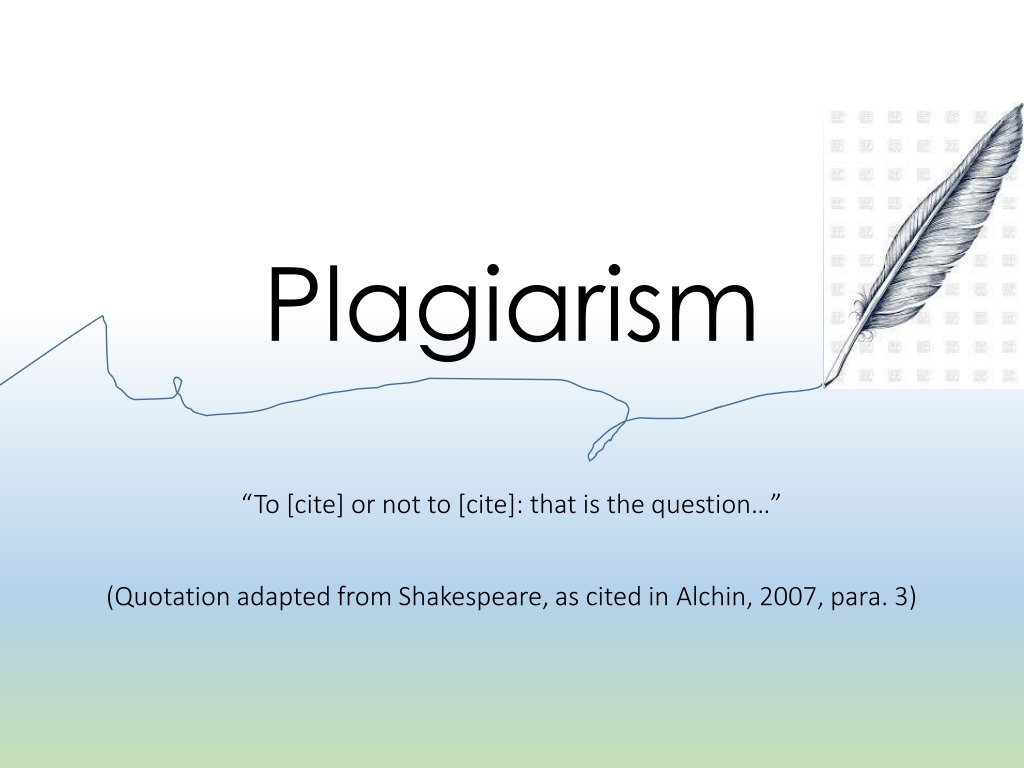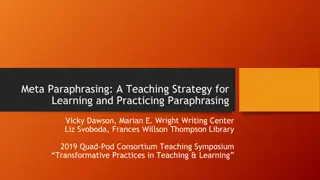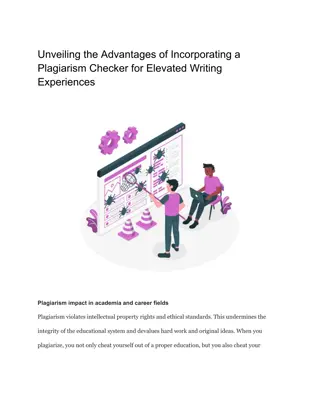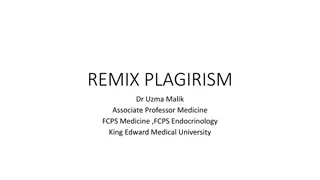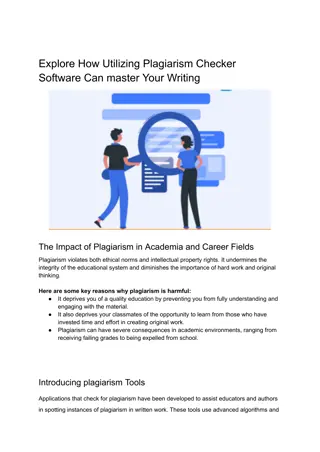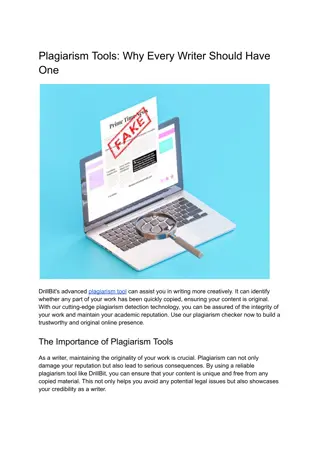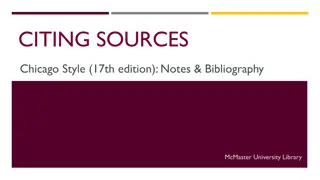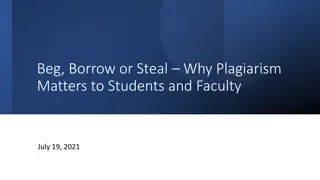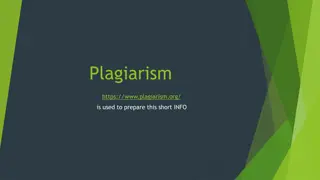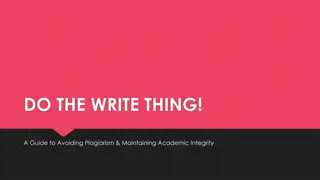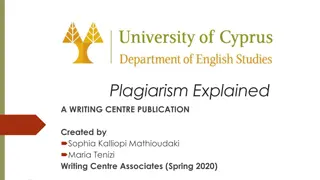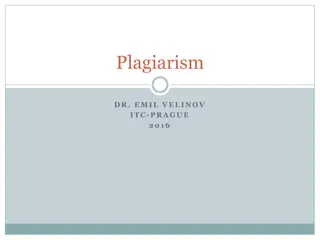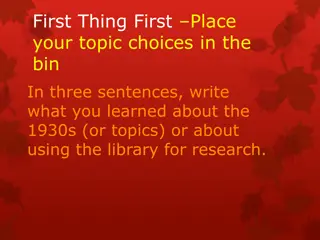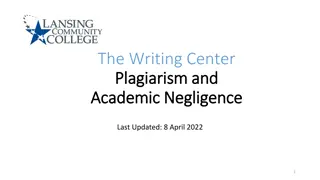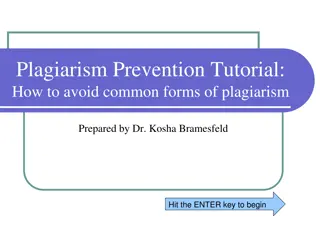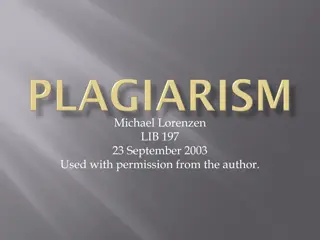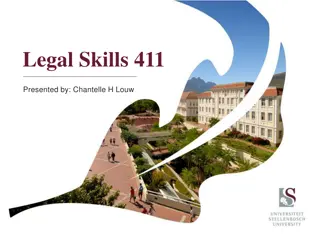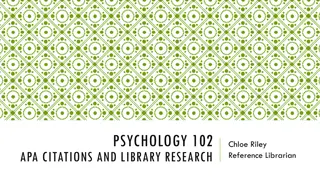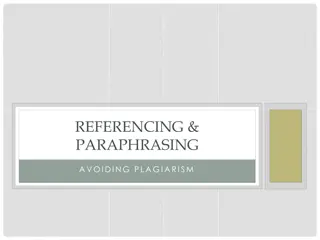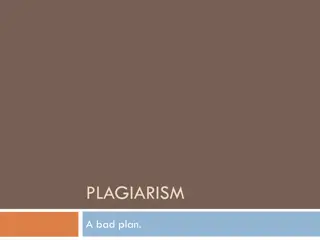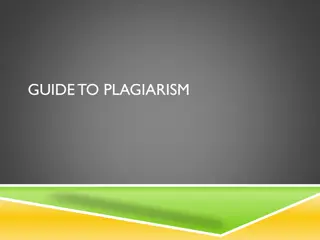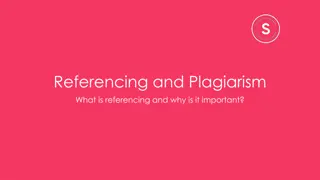Plagiarism: Citing Sources Ethically
Plagiarism is a serious offense that involves stealing ideas or words without proper attribution. Learn about the definition of plagiarism, Plymouth State University's plagiarism policy, and examples of plagiarism. Understand the importance of crediting sources and avoiding academic dishonesty.
Download Presentation

Please find below an Image/Link to download the presentation.
The content on the website is provided AS IS for your information and personal use only. It may not be sold, licensed, or shared on other websites without obtaining consent from the author.If you encounter any issues during the download, it is possible that the publisher has removed the file from their server.
You are allowed to download the files provided on this website for personal or commercial use, subject to the condition that they are used lawfully. All files are the property of their respective owners.
The content on the website is provided AS IS for your information and personal use only. It may not be sold, licensed, or shared on other websites without obtaining consent from the author.
E N D
Presentation Transcript
Plagiarism To [cite] or not to [cite]: that is the question (Quotation adapted from Shakespeare, as cited in Alchin, 2007, para. 3)
Definition of Plagiarism According to Merriam-Webster s online dictionary, to plagiarize means to steal and pass off (the ideas or words of another) as one s own or to use (another s production) without crediting the source ( Plagiarize, as cited in Merriam-Webster s Online Dictionary, n.d., para. 1).
PSUs Plagiarism Policy If you are caught plagiarizing at Plymouth State University, you will be brought before the Academic Integrity Panel. Based on the severity of the offense, you may fail the assignment, fail the course, be suspended, or be expelled ( Academic Standing Policies & Procedures, 2010).
Plagiarism in the News Read more about plagiarism in The New York Times http://www.nytimes.com/2010/08/02/education/02cheat.html?_r=2&ad xnnl=1&adxnnlx=1282827666-IF313jeK0sODdBpQ3GDlfA (Gabriel, 2010)
Examples of Plagiarism Paraphrasing without giving credit to the original source Paraphrasing without giving credit to the original source Directly quoting from a source without using quotation marks and Directly quoting from a source without using quotation marks and citing properly citing properly Using one s own material without citing oneself (either copying a paper Using one s own material without citing oneself (either copying a paper or cutting and pasting) or cutting and pasting) Omitting citations and references on presentations such as Omitting citations and references on presentations such as PowerPoints Cutting and pasting materials from online sources without properly Cutting and pasting materials from online sources without properly citing citing PowerPoints (G. Mears, personal communication, August 15, 2010) *Note: Personal communication citations are not included in the reference list.
Crediting Others ORIGINAL SOURCE ORIGINAL SOURCE: Whether paraphrasing, quoting an author directly, or describing an idea that influenced your work, you must credit the source. DIRECT QUOTATION DIRECT QUOTATION: According to the American Psychological Association s Publication Manual, 6th edition (2010), Whether paraphrasing, quoting an author directly, or describing an idea that influenced your work, you must credit the source (p. 170). Direct Quotation ORIGINAL SOURCE ORIGINAL SOURCE: Whether paraphrasing, quoting an author directly, or describing an idea that influenced your work, you must credit the source. PARAPHRASE PARAPHRASE: It is important to properly cite materials or thoughts that are not your own (American Psychological Association, 2010). Paraphrase
Practice: Which One is Correct? Although there are many different kinds of counselors, all tend to have had common coursework in professional orientation (e.g., history and ethics), the helping relationship, group work, human growth and development, social and cultural foundations, career and lifestyle development, testing and assessment, and research and program evaluation. Original Source: Original Source: Neukrug, E. (2007). The world of the counselor: An introduction to the counseling profession (3rd ed.). Belmont, CA: Thomson Brooks/Cole. 1) Although there are many different kinds of counselors, they ve all had common coursework (Neukrug, 2007). 2) The types of courses that counselors take are similar for many various types of counselors (Neukrug, 2007). Paraphrase Examples
Answer The second one is correct. In the first one, the writer used exact wordings from the original source without quoting them.
Practice: Which One is Correct? The challenge for all counselors is to be capable of building strong relationships with their clients within the context of their theoretical frameworks, and to understand and appreciate how these bonds dramatically affect work with clients. Original Source: Neukrug, E. (2007). The world of the counselor: An introduction to the counseling profession (3rd ed.). Belmont, CA: Thomson Brooks/Cole. 2) The challenge for all counselors is to be capable of building strong relationships with their clients within the context of their theoretical frameworks, and to understand and appreciate how these bonds dramatically affect work with clients (Neukrug, 2007, p. 17). Direct Quotation Examples 1) The challenge for all counselors is to be capable of building strong relationships with their clients within the context of their theoretical frameworks, and to understand and appreciate how these bonds dramatically affect work with clients (Neukrug, 2007).
Answer Once again, the second example is correct. In the first example, the author forgot to include the page number of the direct quotation from the original source.
Practice: Which One is Correct? Accreditation in the United States is a unique peer review system of quality assurance. For CACREP, this means that programs voluntarily submit a self-study that is reviewed against the CACREP Standards by counselors and counselor educators to ensure that students receive a quality educational experience. Original Source: Council for Accreditation for Counseling and Related Educational Programs. (2010). What is accreditation?: Accreditation basics. Retrieved from http://www.cacrep.org/index.cfm /what-is-accreditation 1) CACREP accreditation means that programs voluntarily submit a self-study that is reviewed against the CACREP Standards by counselors and counselor educators to ensure that students receive a quality educational experience (Council for Accreditation for Counseling and Related Educational Programs, 2010, para. 2). Direct Quotation Examples 2) CACREP accreditation means that programs voluntarily submit a self-study that is reviewed against the CACREP Standards by counselors and counselor educators to ensure that students receive a quality educational experience.
Answer The first example is correct. In the second example, the writer copied a direct quotation from the web site without quoting or referencing the original source.
Practice: Which One is Correct? CACREP Accreditation provides recognition that the content and quality of the program has been evaluated and meets standards set by the profession. The student, as a consumer, can be assured that appropriate knowledge and skill areas are included and that the program is stable, professionally and financially. Original Source: Council for Accreditation for Counseling and Related Educational Programs. (2010). Why should I choose an accredited program? Retrieved from http://www.cacrep.org/template/ page.cfm?id=12 1) Counseling programs should strongly consider CACREP accreditation, for the organization recognizes that the content and quality of the program has been evaluated and meets certain standards (Council for Accreditation for Counseling and Related Educational Programs, 2010). 2) Counseling programs that have been accredited by CACREP provide students with a solid repertoire of competencies appropriate to the counseling profession (Council for Accreditation for Counseling and Related Educational Programs, 2010). Paraphrase Examples
Answer The second example is correct. Although the source is cited in the first example, the writer copied direct phrases from the source without using quotation marks.
Practice: Which One is Correct? *Note: The writer of these examples is Gail Mears. Prior to the seventies, counselors working in mental health settings had no certification or licensure and had no professional organization with which to identify. Original Source: Mears, G. F. (2006). American mental health counselors association: Taking the profession into the 21st century. In Palmo, A. J., Weikel, W. J., & Borsos, D. P. (Eds.), Foundations of mental health counseling (3rd ed.)(pp. 49-54). Springfield, IL: Charles C. Thomas Publisher, Ltd. Direct Quotation Examples 1) Prior to the seventies, counselors working in mental health settings had no certification or licensure and had no professional organization with which to identify (Mears, 2006, p. 49). 2) Prior to the seventies, counselors working in mental health settings had no certification or licensure and had no professional organization with which to identify.
Answer The first example is correct. Even The first example is correct. Even though the writer, Dr. Gail Mears, though the writer, Dr. Gail Mears, wrote the original document, she still wrote the original document, she still needs to cite herself if she uses her needs to cite herself if she uses her own past work. own past work.
True/False Quiz 1. In using direct quotations, it is important to use quotation marks and include a page number or paragraph number where the quotation was obtained. 2. When paraphrasing other sources, it s okay to use similar wordings to make sure that the statement is similar to the original source. 3. Material taken from the Internet is free to the public, and thus, does not need to be cited. 4. Using material from a previously self-written document must be cited when used in any subsequent works. 5. When creating a PowerPoint, references must be included at the end.
Answers 1. 1. True True: It s important to use quotation marks and cite the exact page or paragraph number when using direct quotations. 2. 2. False False: Although it is important to convey the same message as the original source, you cannot use exact wordings without quoting them directly. 3. 3. False False: Everything taken from the Internet must be cited properly. 4. 4. True True: Self-plagiarism is also a form of plagiarism. 5. 5. True True: PowerPoint presentations must include references.
References * Note: Remember to include references in PowerPoint Presentations! Academic Standing Policies & Procedures. (2010). In Plymouth State University academic policies. Retrieved September 8, 2010, from http://www.plymouth.edu/registrar/policies/academic_standing.html Alchin, L. (2007). William Shakespeare quotes and quotations. Retrieved September 2, 2010, from http://www.william-shakespeare.info/william-shakespeare-quotes.htm American Psychological Association. (2010). Publication manual of the American Psychological Association (6th ed.). Washington, DC: American Psychological Association. Council for Accreditation for Counseling and Related Educational Programs. (2010). Why should I choose an accredited program? Retrieved August 31, 2010, from http://www.cacrep.org/template/page.cfm?id=12 Et Plagieringseventyr. (2010, May 27). [YouTube video]. Retrieved from http://www.youtube.com/watch?v=Mwbw9KF-ACY Gabriel, T. (2010, August 1). Plagiarism lines blur for students in digital age. The New York Times. Retrieved from http://www.nytimes.com/2010/08/02/education/02cheat.html?_r=2&adxnnl=1&adxnnlx=1282827666-IF313jeK0sODdBpQ3GDlfA Mears, G. F. (2006). American mental health counselors association: Taking the profession into the 21st century. In Palmo, A. J., Weikel, W. J., & Borsos, D. P. (Eds.), Foundations of mental health counseling (3rd ed.)(pp. 49-54). Springfield, IL: Charles C. Thomas Publisher, Ltd. Neukrug, E. (2007). The world of the counselor: An introduction to the counseling profession (3rd ed.). Belmont, CA: Thomson Brooks/Cole. Plagiarize. (n.d.) In Merriam-Webster s online dictionary (33 ed.). Retrieved September 2, 2010, from http://www.merriam- webster.com/dictionary/plagiarize?show=0&t=1283434152
Academic Integrity Agreement I __________________ (print full name) understand the seriousness of plagiarism. In signing this document, I understand that if I am caught plagiarizing, I will be brought before the Plymouth State University Academic Integrity Panel. Based on the severity of the offense, I may fail the assignment, the course, be suspended, or be expelled. Signature: ______________________ Date:___________ *This form must be signed and submitted to your course instructor.
